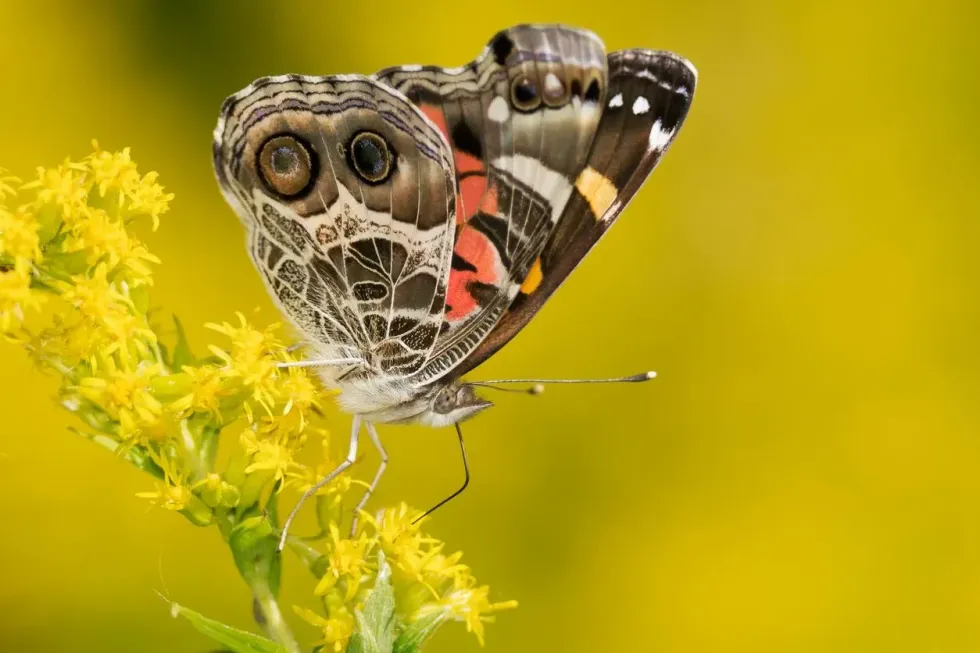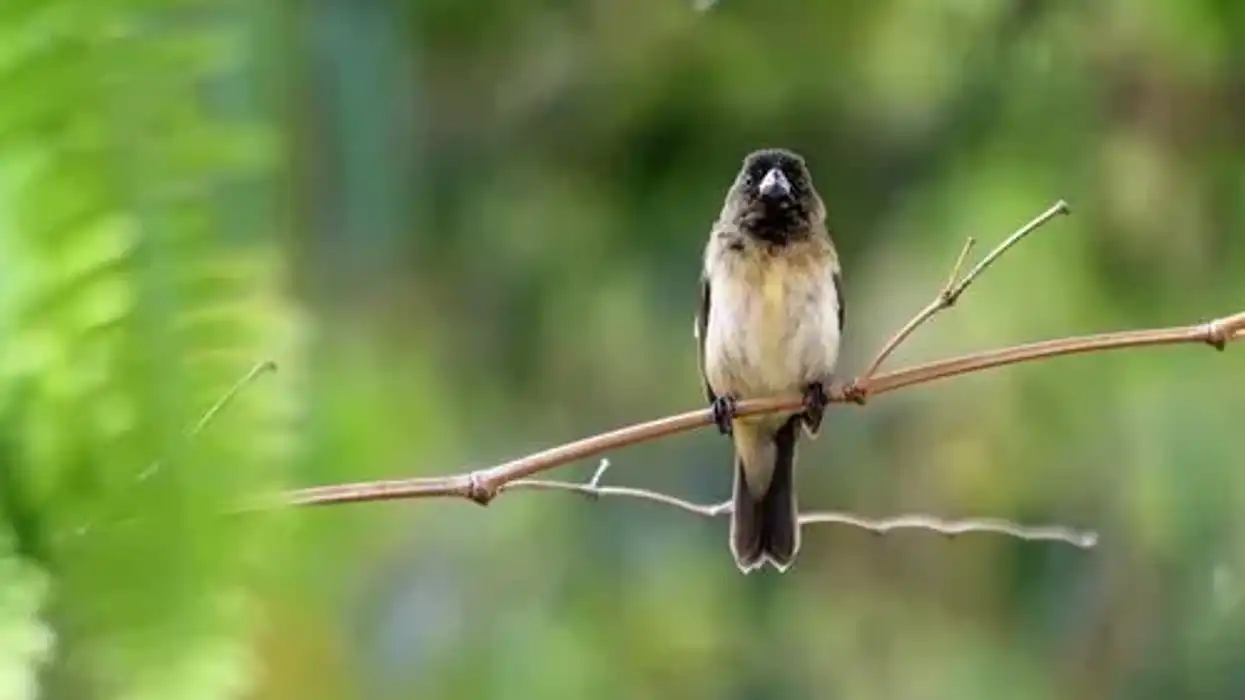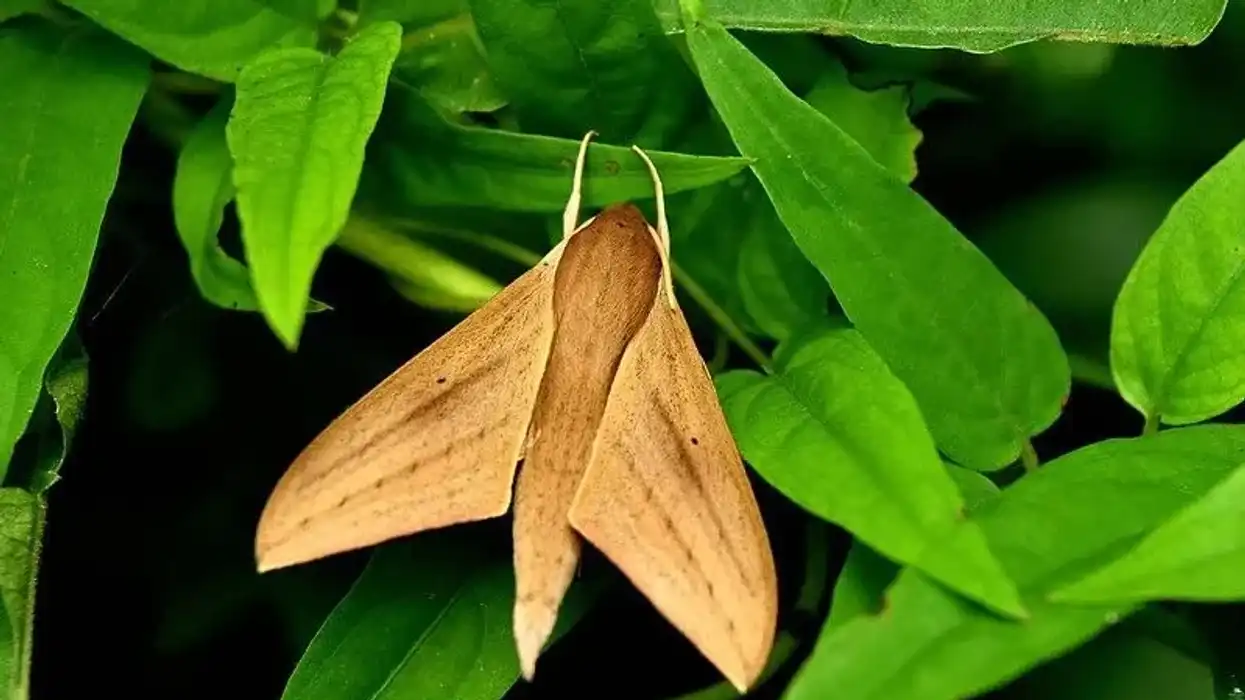Butterflies are considered Holy spirits in the Bible. Watching them flying in your garden or open meadows brings immense joy. Let us study some exciting facts about the American lady butterfly, widely found in North America.
The other common names of American lady butterflies are Painted Beauty, Hunter's Butterfly, and American painted lady. Generally found very close to the ground, they are known to be observed in all Alabama counties.
The American lady butterfly is a habitat generalist so can be found anywhere if its host plants are around.
Though this butterfly resembles the Painted Lady Vanessa Cardui and the West Coast Lady Vanessa Annabella, they are distinguished by two large eyespots under the surface of the hindwings. This active butterfly is famous for its distinguished nests made by caterpillars.
The adult species are found in two seasonal forms. The early season is bright-colored and more prominent in size, whereas the late seasonal form is minor in size and paler in color with fewer black markings.
To know more interesting facts about this American lady butterfly, get into the details given below. Also, go through our blue morpho butterfly and viceroy butterflies facts for a good read.
American Lady Butterfly Interesting Facts
What type of animal is an American Lady Butterfly?
The American lady butterfly is an insect with a beautiful color combination of black and orange, with small white spots on its hind wings, and flies on the host plants searching for its nectar.
What class of animal does an American Lady Butterfly belong to?
The American lady butterfly, which belongs to the Insecta class and family Nymphalidae, is a medium-sized butterfly, that resembles the Painted Lady Vanessa Cardui and the West Coast Lady Vanessa Annabella.
How many American Lady Butterflies are there in the world?
American lady butterflies are found in abundance in their habitat. The total count of these species is unknown, but all the stages of these species are found widely in North America, Central America Madeira, and the Canary Islands.
Where does an American Lady Butterfly live?
These butterflies are found throughout North America, Madeira, and the Canary Islands. Occasionally it is seen in Southwest Europe and Hawaii.
What is an American Lady Butterfly's habitat?
Butterflies are found in all habitats, from forests to open areas. We can locate them on almost all the continents, except Antarctica. Likewise, these species of butterflies are found in open areas such as fields, meadows, vacant lots, and beach dunes, maybe sometimes roadside.
Who do American Lady Butterflies live with?
The beauty of the surroundings is enhanced by the presence of these flying wonders. Though they don't fly in flocks, like birds in the sky, these beautiful insects fly in groups and occasionally alone.
Suppose you found any host plants such as pearly everlasting, you can see these butterflies roosting over it. As we all know, this insect class has a liquid diet and largely depends on the colorful flowers to feed on their nectar.
How long does an American Lady Butterfly live?
Butterflies are short-lived creatures. The life span of an adult American lady is 6-20 days.
The caterpillar or larvae stage, which emerges from yellow or green eggs, ranges from two to four weeks; during this stage, these larvae widely depend on the host plants such as everlasting or cudweed herbs.
Later it enters into the chrysalis or pupal stage ranging from 7-14 days. The last stage is the adult American butterfly, whose main agenda is to suck the nectar and lay eggs to restart the cycle—completing all the stages of its lifecycle.
How do they reproduce?
The American lady reproduces through sexual reproduction. The male butterfly seduces the female one by releasing pheromones at very close range.
Suppose a female is interested, then mating usually takes place on the top of the trees. During this process, males and females go on the courtship flight, which lasts for an hour. The female butterfly lays eggs after mating on host plants like everlasting, ironweed, and cudweed, usually on the top layer of the leaves of the plants.
The eggs are yellow-green in color, small and barrel-shaped. They blend with the host plants very perfectly.
The American lady butterfly caterpillar forms nests on the host plants in the caterpillar stage. Usually, caterpillars spend most of their time eating and gaining an incredible amount of weight. When not eating, they rest in the nest formed at the base of host plants.
The length of full-grown larvae is approximately 1.4 in (3.6 cm) long. The caterpillar hangs upside down and pulls itself, and forms slightly J-shaped pre-pupation forms with the help of anal prolegs. Caterpillar finds a suitable spot to pupate by forming a protective shell known as a chrysalis.
Pupae are 0.75 in (1.9 cm) long, either in green with purple markings or gray with dark markings. Inside the shell, this larva changes into a butterfly.
What is their conservation status?
The conservation status of these butterflies is G5- Globally Secure (as per NatureServe).
American Lady Butterfly Fun Facts
What do American Lady Butterflies look like?
The American lady butterfly has uneven forewings in brown, yellow, and orange patterns. This medium-sized butterfly has male forewing length ranges from 1.023-1.377 in (2.6-3.5 cm).
The concave forewing part has a black patch and a tiny white spot with a red-orange band. The lower side of the hindwings is occupied by two large eye spots which resemble the cob-web pattern.
How cute are they?
Butterflies are delicate and winged insects that are beautiful creations. They remind us that change is inevitable, and their four stages of the life cycle symbolize change, hope, and patience. This orange-winged butterfly refreshes our moods and brings immense joy and peace; it is cute species that enhance surroundings and make them more colorful.
How do they communicate?
In general, butterflies communicate through sounds, color, scents and chemicals, and physical actions. For example, chemical pheromones are used to seduce the opposite sex. Some butterflies produce clicking sounds with their wings, and some caterpillars produce sugar substances for ants which in turn protect the caterpillars. However, much is not known about the communication of this particular butterfly.
How big is an American Lady Butterfly?
The wingspan of the American lady butterfly is 1.75-2.62 in (4.5-6.7 cm), which is minutely less than the wingspan of its close cousin the painted lady at 2-2.9 in (5.1-7.3 cm).
How fast can American Lady Butterflies fly?
American ladies are fast-flying butterflies though the exact speed of these winged creatures is not known.
How much does an American Lady Butterfly weigh?
The exact weight of this butterfly is not known, but on average, the weight of any butterfly is 0.017 oz (0.5 g).
What are the male and female names of the species?
The male is called the male American lady butterfly, and the female is known as the female American lady butterfly. The male butterfly has a smaller abdomen when compared to the female.
What would you call a baby American Lady Butterfly?
The young butterfly is usually called a larva. These caterpillars are usually in sage green and burgundy color blend with the surroundings. After that, a chrysalis in yellow/green color is formed, which usually shines at night. According to its surroundings, this butterfly pupates in different colors in dull, bright, or shiny colors.
What do they eat?
These are early spring butterflies who enjoy nectar from a wide variety of flowering plants such as aster, selfheal, goldenrod, and marigold. In comparison, larvae feed on a limited range of host plants such as sweet everlasting, pearly everlasting, and plantain-leaved pussytoes. They occasionally depend on wormwood, burdock, and ironweed.
Male butterflies are found sipping moisture and nutrients from damp soil. Female flies at low heights in search of nectar from the host plants.
Are they dangerous?
The word dangerous does not fit these colorful creatures. But farmers consider caterpillars as pests as sometimes they harm the crops and vegetation.
Would they make a good pet?
Watching Metamorphosis is a very interesting part. Some people are very fond of rearing these colorful, delicate, and winged creatures.
Proper space and environment are vital for taking this as a hobby as caterpillars spend most of their time eating. So start providing proper suitable host plants placed in a glass of water.
Placing in water keeps the food fresh for the caterpillars. This stage lasts about two to four weeks and then enters to pupate stage, where enough space should be provided to form a cocoon.
This stage is known as the chrysalis stage. Once the butterfly comes out of the cocoons, you can either choose to give them freedom by letting them free in an open space or providing an ample amount of space and food and a suitable environment for the further recycling process.
Did you know...
The eggs are hatched during the late summer/fall. During the overwintering stage, the adult American lady hibernate or is seen as pupae. On sunny days such as in May, these adults become active. All the active butterflies are the previous year's summer specimens, some hibernating as butterflies and some overwintering as pupae.
The flight period of these butterflies in New York City is from the first half of May to the first half of July.
The number of broods ranges from three to four.
Do American Lady Butterflies migrate?
Yes, the American-painted lady butterfly is known for its migration abilities. The American lady, Vanessa virginiensis, migrates because of westerly winds to Western European countries such as the British Isles, Portugal, Madeira, and western Spain. This brush foot family butterfly is also observed in the Adirondack Mountains during the months of June-August.
They migrate and form temporary colonies in Southern Canada, Northern parts of the USA, and the West Indies. Originally native to the Canary Islands, it is also found in Southern Portugal.
The migrations mostly occur during the spring season. However, studies suggest that the exact reason for these migrations is not known.
American Lady Butterfly vs Painted Lady Butterfly
Though both the American Lady and Painted Lady look similar at first glance, they have prominent differences in their wing markings.
The American lady has a small white spot inside the postmedian area of the forewing. Painted ladies lack this white spot. They also differ in the number of eyespots. The American lady has two eyespots on the ventral side of her wings, whereas the Painted ladies have four eyespots on their ventral side, which are smaller in size.
American lady butterflies are more cold-tolerant than the Painted ladies.
The Painted lady is widespread in England, Scotland, Ireland, and Wales, whereas the American lady is found in North America and the Canary Islands.
Here at Kidadl, we have carefully created lots of interesting family-friendly animal facts for everyone to discover! Learn more about some other arthropods from our morpho butterfly fun facts, and purple emperor butterfly facts pages.
You can even occupy yourself at home by coloring in one of our free printable American lady butterfly coloring pages.









